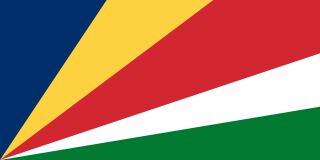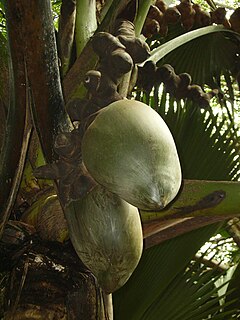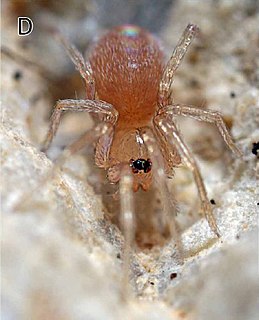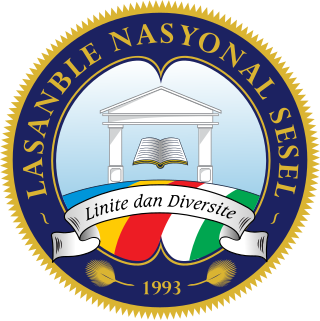Contents
This is a list of museums in Seychelles .
This is a list of museums in Seychelles .

Seychelles, officially the Republic of Seychelles, is an archipelagic island country consisting of 115 islands in the Indian Ocean at the eastern edge of the Somali Sea. Its capital and largest city, Victoria, is 1,500 kilometres east of mainland Africa. Nearby island countries and territories include the Comoros, Madagascar, Mauritius, and the French overseas regions of Mayotte and Réunion to the south; and Maldives and the Chagos Archipelago to the east. It is the least populous sovereign African country, with an estimated 2020 population of 98,462.

Entomology is the scientific study of insects, a branch of zoology. In the past the term "insect" was less specific, and historically the definition of entomology would also include the study of animals in other arthropod groups, such as arachnids, myriapods, and crustaceans. This wider meaning may still be encountered in informal use.

Lodoicea, commonly known as the sea coconut, coco de mer, or double coconut, is a monotypic genus in the palm family. The sole species, Lodoicea maldivica, is endemic to the islands of Praslin and Curieuse in the Seychelles. It has the biggest seed in a plant. It formerly also was found on the small islets of St Pierre, Chauve-Souris, and Ile Ronde, all located near Praslin, but had become extinct there for a time until recently reintroduced. The name of the genus, Lodoicea, may be derived from Lodoicus, one Latinised form of Louis, in honour of King Louis XV of France. Other sources say that Lodoicea is from Laodice, the daughter of Priam and Hecuba.

Oonopidae, also known as goblin spiders, is a family of spiders consisting of over 1,600 described species in about 113 genera worldwide, with total species diversity estimated at 2000 to 2500 species. The type genus of the family is OonopsKeyserling, 1835.

The flag of Seychelles was adopted on January 8, 1996. The current flag is the third used by the country since its independence from Britain on June 29, 1976. The colours used in the current flag are the official colours of two of the nation's major political parties: the Seychelles People's United Party and the Seychelles Democratic Party.

Victoria is the capital and largest city of the Republic of the Seychelles, situated on the north-eastern side of Mahé island, the archipelago's main island. The city was first established as the seat of the British colonial government. In 2010, the population of Greater Victoria was 26,450 (26.66%) out of the country's total population of 99,202.

The Aldabra giant tortoise is a species of tortoise endemic to the islands of the Aldabra Atoll in the Seychelles. It is one of the largest tortoises in the world. Historically, giant tortoises were found on many of the western Indian Ocean islands, as well as Madagascar, and the fossil record indicates giant tortoises once occurred on every continent and many islands with the exception of Australia and Antarctica. Many of the Indian Ocean species were thought to be driven to extinction by over-exploitation by European sailors, and they were all seemingly extinct by 1840 with the exception of the Aldabran giant tortoise on the island atoll of Aldabra. Although some remnant individuals of A. g. hololissa and A. g. arnoldi may remain in captivity, in recent times, these have all been reduced as subspecies of A. gigantea.

Sooglossidae, the Seychelles frogs or Seychelles Island frogs, are a family of frogs found on the Seychelles Islands. Until recently, this family was believed to include the genera Sechellophryne, Nesomantis and Sooglossus, but following a major revision of amphibians in 2006, the genus Nesomantis was named a junior synonym of Sooglossus. Their closest relatives are the purple frogs (Nasikabatrachidae) of India.

The unicameral National Assembly is the Seychelles's legislative body.

The Seychelles parakeet or Seychelles Island parrot is an extinct species of parrot that was endemic to the Seychelles in the Indian Ocean. It was scientifically named Palaeornis wardi by the British ornithologist Edward Newton in 1867, and the specific name honours the British civil commissioner Swinburne Ward who procured the specimens that formed the basis for the description. It was found on the islands of Mahé, Silhouette, and possibly Praslin. Ten skin specimens exist today, but no skeletons. Though it was later moved to the genus Psittacula, genetic studies have led some researchers to suggest it should belong in a reinstated Palaeornis along with the closely related Alexandrine parakeet of Asia.

Ochyroceratidae is a six-eyed spider family, with 165 described species in ten genera. They are common inhabitants of caves and the tropical forest litter of South Africa, the Caribbean, Asia and South America. Considered an ecological counterpart of the Linyphiidae of the northern temperate zone, species are especially diverse in the Indo-Pacific region.
Hampton Wildman Parker was an English zoologist.

The Aldabra flying fox is a species of megabat in the genus Pteropus. It is endemic to the Aldabra Atoll in the Seychelles, like Chaerephon pusilla, though the latter may be the same species as the little free-tailed bat.

The following outline is provided as an overview of and topical guide to Seychelles:
Articles related to Seychelles include:

The history of Seychelles dates back to the fourth of the Portuguese India Armadas led by Vasco da Gama, though Seychelles was likely already known to Arab navigators and other sailors for many centuries. On 15 March 1503, the scrivener Thomé Lopes noted the sighting of an elevated island, doubtless one of the granitic islands and almost certainly Silhouette Island. The first recorded landing was by the men of the English East India Company ship Ascension, which arrived in Seychelles in January 1609. The islands were claimed by France in 1756. Seychelles remained uninhabited until the first settlers arrived on board the ship Thélemaque, which arrived on 27 August 1770. Captain Leblanc Lecore landed the first colonists, comprising 15 white men, eight Africans and five Indians. The Seychellois Creole language developed as a means of communication between the different races. The British frigate Orpheus commanded by Captain Henry Newcome arrived at Mahé on 16 May 1794. Terms of capitulation were drawn up and the next day Seychelles was surrendered to Britain. Following the fall of Mauritius to British forces, Captain Phillip Beaver of the Nisus arrived at Mahé on 23 April 1811 and took possession of Seychelles as a permanent colony of Britain. The Seychelles became an independent republic in 1976. Following a coup d'état, a socialist one-party state ruled the country from 1977 to 1993. The subsequent democratic Presidential elections were won by candidates of the same party.
A museum is an institution that cares for (conserves) a collection of artifacts and other objects of artistic, cultural, historical, or scientific importance and makes them available for public viewing through exhibits that may be permanent or temporary. According to Museums of the World, there are about 55,000 museums in 202 countries. The International Council of Museums comprises 30,000 members in 137 countries.

The Seychelles Natural History Museum is a natural history museum in the Seychelles.
Michael I. Saaristo was a Finnish arachnologist, with a particular interest in the spiders of the Seychelles. The World Spider Catalog lists 61 genus names or synonyms and 109 species names or synonyms of which he is the sole or co-author.
Events in the year 2020 in Seychelles.